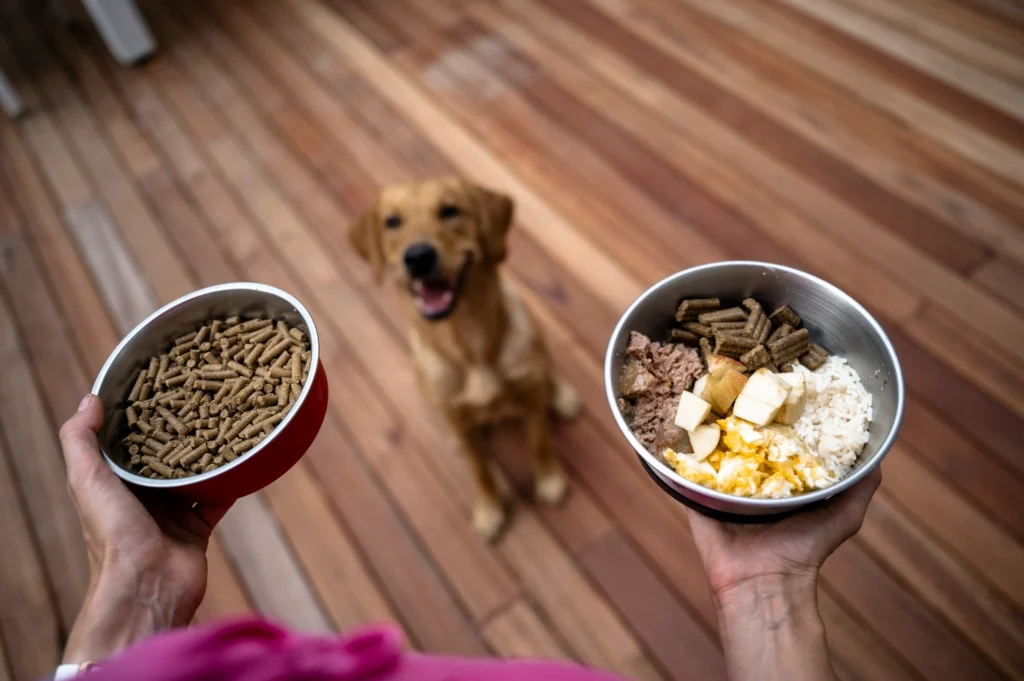The debate over Grain-Free Dog Food has become increasingly confusing for dog owners. Marketed as a natural and superior choice, many believe it is essential for dogs with allergies or digestive sensitivities. However, recent warnings from the FDA have raised concerns about a potential link between certain grain-free formulas and serious heart conditions, specifically Dilated Cardiomyopathy (DCM in dogs).
This comprehensive 2025 guide cuts through the marketing hype, explaining the real benefits, potential risks, and expert tips for selecting the best vet-reviewed grain-free dog food. Make an informed choice for your furry friend today.

Understanding Grain-Free Dog Food: Benefits & Misconceptions
Why has Grain-Free Dog Food become so popular? The main reason is the misconception that grains are simply “fillers” or that dogs are inherently grain-intolerant, similar to gluten sensitivity in humans.
Benefits of Grain-Free Dog Food
Addressing Grain Sensitivities
True grain allergies are rare in dogs, but some owners notice improvements in skin and coat health when avoiding common grains like wheat or corn.
Novel Protein Focus
High-quality grain-free diets often prioritize meat as the primary ingredient, appealing to owners seeking a high-protein diet for their dogs.
Digestive Ease
For dogs with true grain-related digestive issues, a veterinarian-approved grain-free formula may help reduce stomach upset.
⚠️ Note: “Grain-free” does not mean “carbohydrate-free.” Many diets replace grains with potatoes, peas, or lentils, which have been implicated in some health concerns.
The Risks of Grain-Free Diets: DCM in Dogs Explained
The most serious risk associated with grain-free diets is their potential link to Dilated Cardiomyopathy (DCM in dogs), a severe heart disease that can lead to heart failure.
Key Facts About the Risk:
-
Taurine Deficiency: Diets high in legumes and potatoes may interfere with the absorption or metabolism of essential amino acids, especially taurine, critical for heart function.
-
BEG Diet Concern: Diets under investigation often fall under Boutique, Exotic ingredient, and Grain-free (BEG) formulas.
-
FDA Investigation: In 2018, the FDA examined DCM cases in breeds not typically genetically prone to the disease. A common factor was diets with high levels of peas, lentils, or potatoes.
Expert Recommendation:
Always consult a veterinary nutritionist before feeding a grain-free diet. Ensure the product meets AAFCO feeding trials and nutritional standards.
How to Choose the Best Vet-Reviewed Grain-Free Dog Food
If you and your veterinarian decide a grain-free diet is appropriate, follow these three expert steps to minimize risks:
1. Prioritize High-Quality Protein
Choose foods where the first ingredients are specific meat proteins, such as Chicken Meal or Salmon Meal, instead of vague terms like “Meat By-Products.”
2. Avoid Excessive Legumes
Check the ingredient list carefully. Peas, lentils, or potatoes should not be the first or second ingredient. These should supplement, not replace, the primary protein source.
3. Look for Veterinary Expertise
Select brands formulated by PhD or DACVN-certified veterinary nutritionists. This scientific approach significantly lowers the risk of nutritional deficiencies.
Trusted Brands & Expert Recommendations
Finding a reliable grain-free dog food requires research:
-
Look for brands with decades of reputable history.
-
Ensure they conduct feeding trials and provide transparent ingredient sourcing.
-
Consult your veterinarian, who can recommend products not implicated in FDA DCM reports and perform taurine testing if needed.
Internal Resource Suggestion:
-
-
For protein-focused diets, check our Nutra Complete Dog Food Review.
-
External References:
FAQ About Grain-Free Dog Food
Q1: Does “Grain-Free” automatically mean allergy-friendly?
A: No. Most dog allergies are related to protein sources like beef or chicken, not grains. Identify the specific allergen with a vet before changing food.
Q2: How can I safely transition to Grain-Free Dog Food?
A: Gradually mix the new food over 7-10 days, increasing the proportion each day to prevent digestive upset.
Q3: Are all grain-free diets linked to DCM in dogs?
A: No. The concern mainly applies to diets high in legumes or potatoes. Many high-quality grain-free diets exist, but always consult your veterinarian.
Compliance Statement
This article is informational only and not a substitute for professional veterinary advice. Consult your veterinarian or a board-certified veterinary nutritionist before making significant dietary changes, particularly regarding risks like DCM.